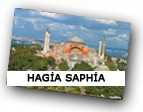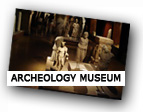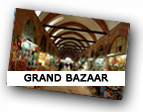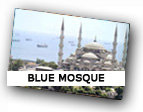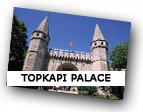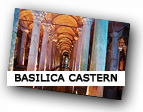


Useful Info
Hagia Sophia

One of the most famous monuments of Turkish and Islamic art, the mosque is visited by all who come to Istanbul and gains their admiration.
This imperial mosque is an example of classical Turkish architecture, and it is the only mosque that was originally built with six minarets.
It is surrounded by other important edifices of Istanbul, built at earlier ages. Istanbul is viewed best from the sea and the mosque is part of this magnificent scenery.
Although it is popularly known as the Blue Mosque, its real name is Sultan Ahmet Mosque. Befitting his original profession, its architect Mehmet Aga decorated the interior fastidiously like a jeweler. Built between 1609-1616, the mosque used to be part of a large complex, including a covered bazaar, Turkish baths, public kitchens, a hospital, schools, a caravanserai, and the mausoleum of Sultan Ahmet. Some of these social and cultural buildings have not survived to our day.
The architect was a student of Sinan, the greatest architect of classical Turkish architecture. He applied a plan used previously by his master, but on a larger scale.
The main entrance to Sultan Ahmet Mosque is on the Hippodrome side. There is an outer courtyard, and the inner courtyard and the edifice itself are elevated.
From the gate opening to the inner courtyard one can view the domes, rising above one another in perfect harmony, over the symbolic ablution fountain in the middle and the surrounding porticoes.
There are three entrances to the mosque interior. The wealthy and colorful vista inside created by the paintings, tiles and stained glass complements the exterior view. The interior has a centralized plan; the main and side domes rise on four large columns that support broad and pointed arches. The walls of the galleries surrounding the three sides of the interior chamber are decorated by over 20,000 exquisite Iznik tiles. The areas above the tiles and the inside of the domes are decorated with paintwork.
The blue of the paintwork, which gives the mosque its name, was not the color of the decorations originally; they were painted blue during later restorations. During the last renovation, completed in 1990, the darker blue color of the interior decorations painted as its original light colors.
The floor is covered by carpets, as in all mosques. Next to the mihrab (niche aligned towards Mecca) opposite the main entrance, there is a marble minber (pulpit) with exquisite marble work. On the other side is the sultan's loge (box) in the form of a balcony. The 260 windows flood with light the interior space, which is covered by a dome 23.5 m in diameter and 43 m high.
The small market building, repaired and reconstructed in recent years, is situated to the east of the mosque, and the single-domed mausoleum of Sultan Ahmet and the medrese (religious school) building are to the north, on the Hagia Sophia side.
In summer months light and sound shows are organized in the park here. Sultan Ahmet Mosque occupies a focal point in city tours, together with the numerous monumental buildings and museums in the vicinity.
The minarets of the mosque are classical examples of Turkish architecture. The balconies are reached by spiral stairs. It is from these balconies that five times a day the believers are called to prayer - in our day using loudspeakers.
The domes and the minarets are covered by lead, and at the top of the minarets there are standards made of gold-plated copper. Master craftsmen repair these coverings very skillfully when needed.
Islam requires all Muslims to pray five times a day. When the believers hear the call to prayer from the minarets, they perform their ablutions (washing) and then pray. The noon prayer on Fridays and the prayers on other important holidays are performed in the mosques collectively, but other prayers can be performed anywhere.
In the communal prayers performed in the mosque, the imam takes the lead and he chants verses from the Koran. The areas of prayer for men and women are separate. In the central area only men are allowed to pray, while women take their places either behind them or in the galleries.
It is a characteristic of classical Turkish mosques that even in the most crowded day, the majority of the congregation can easily see the mihrab.






